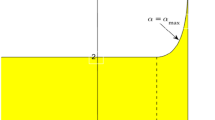Abstract
This paper derives a new splitting-based decomposition algorithm for convex stochastic programs. It combines certain attractive features of the progressive hedging algorithm of Rockafellar and Wets, the dynamic splitting algorithm of Salinger and Rockafellar and an algorithm of Korf. We give two derivations of our algorithm. The first one is very simple, and the second one yields a preconditioner that resulted in a considerable speed-up in our numerical tests.
Similar content being viewed by others
References
Ainassaari, K., M. Kallio, and A. Ranne. (1998). Selecting an optimal investment portfolio for a pension insurance company, in the collection of papers presented in the 8th International AFIR Collogium in Cambridge.
Birge, J.R. (1997). “Stochastic Programming Computation and Applications.” INFORMS J. Comput. 9, 111–133.
Blomvall, J. and P.O. Lindberg. (2002). “A Riccati-Based Primal Interior Point Solver for Multistage Stochastic Programming.” Interior point methods (Budapest, 2000). European J. Oper. Res. 143, 452–461.
Eckstein, J. (1989). “Splitting Methods for Monotone Operators with Applications to Parallel Optimization.” Ph.D. Thesis, Massachusetts Institute of Technology.
Eckstein, J. and D. Bertsekas. (1992). “On the Douglas-Rachford Splitting Method and the Proximal Point Algorithm for Maximal Monotone Operators.” Math. Programming 55 (3), Ser. A, 293–318.
Eckstein, J. and M.C. Ferris. (1998). “Operator-splitting Methods for Monotone Affine Variational Inequalities, with a Parallel Application to Optimal Control.” INFORMS J. Comput. 10, no. 2 218–235.
Golub, G.H. and C.F. Van Loan. (1996). “Matrix Computations.” 3rd edition. Johns Hopkins Studies in the Mathematical Sciences. Johns Hopkins University Press, Baltimore, MD.
Korf, L. (1998). “Approximation and Solution Schemes for Stochastic Dynamic Optimization Problems.” Doctoral Dissertation, University of California Davis.
Mulvey, J.M. and H. Vladimirou. (1991). “Applying the Progressive Hedging Algorithm to Stochastic Generalized Networks.” Stochastic programming, Ann. Oper. Res., 31, 399–424.
Pennanen, T. (2002). “A Splitting Method for Composite Mappings.” Numerical Functional Analysis and Optimization 23, 875–890.
Robinson, S.M. (1991). “Extended Scenario Analysis.” Annals of Oper. Res. 31, 385–398.
Rockafellar, R.T. (1970). “Convex Analysis.” Princeton University Press.
Rockafellar, R.T. (1976). “Monotone Operators and the Proximal Point Algorithm.” SIAM J. Control Optim. 14, 877–898.
Rockafellar, R.T. and R.J-B. Wets. (1991). “Scenarios and Policy Aggregation in Optimization Under Uncertainty.” Math. Oper. Res. 16(1), 119–147.
Ruszczyński, A. (1997.) “Decomposition Methods in Stochastic Programming. Lectures on Mathematical Programming.” Math. Programming 79 (1-3), Ser. B, 333–353.
Salinger, D. (1997). “A Splitting Algorithm for Multistage Sochastic Programming with Application to Hydropower Scheduling.” Ph.D. Thesis, Dept. of Appied Math., University of Washington.
Salinger, D.H. and R.T. Rockafellar. “Dynamic Splitting: An Algorithm for Deterministic and Stochastic Multiperiod Optimization.” preprint.
Spingarn, J.E. (1983). “Partial Inverse of a Monotone Operator.” Appl. Math. Optim. 10, 247–265.
Steinbach, M.C. (2001). “Hierarchical Sparsity in Multistage Stochastic Programs.” Stochastic Optimization: Algorithms and Applications (Gainesville, FL, 2000), pp. 385–410, Appl. Optim., 54, Kluwer Acad. Publ., Dordrecht.
Author information
Authors and Affiliations
Corresponding author
Additional information
The first author was supported by the Finnish Foundation for Economic Education under grants 20728 and 21599, and by Jenny ja Antti Wihuri Foundation.
Rights and permissions
About this article
Cite this article
Pennanen, T., Kallio, M. A splitting method for stochastic programs. Ann Oper Res 142, 259–268 (2006). https://doi.org/10.1007/s10479-006-6171-1
Issue Date:
DOI: https://doi.org/10.1007/s10479-006-6171-1




